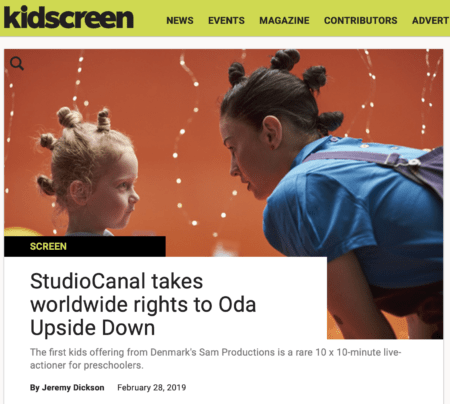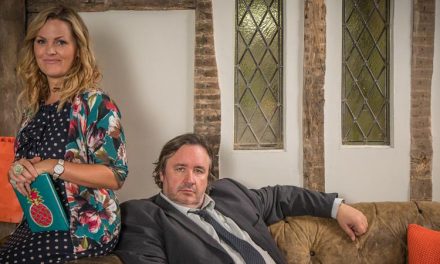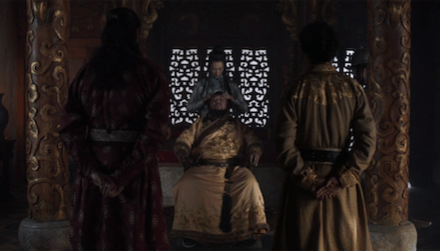By Eva Novrup Redvall
As analyzed in the recent research project “What Makes Danish TV Drama Series Travel?” certain kinds of television fiction from small nations cross borders more easily than others. In this regard crime definitely pays, as highlighted as one aspect among many in the three book publications coming out of the project this year (Agger 2020; Jensen and Jacobsen 2020; Waade et al. 2020).
With the Norwegian youth serial SKAM as the great exception, Nordic live action series targeted at children, tweens and teens rarely travel beyond the Nordic countries. The Nordvision collaboration facilitates programme exchange between the Nordic public service broadcasters – both in the realm of fiction and other genres – but children’s content doesn’t often meet international audiences on a wider scale.
Animated content with no explicit national markers or cultural specificity can be exported, while live action is harder to sell and dub or subtitle. As highlighted by Australian media scholar Anna Potter, live action fiction for children is currently under pressure in many countries, due to fragmentation of the young audiences, new competition from global SVOD services and less funding for public service broadcasters (Potter 2020).
Oda Upside Down as a live action test
While children’s television drama from the Danish public service broadcaster is popular with national audiences, it is rather invisible in the international television landscape. It was thus interesting to recently learn that the children’s serial Oda omvendt (Oda Upside Down), made by Sam Productions for the Danish children’s channel Ramasjang targeting 3-6-year-old children, has been sold to the French pay television channel Piwi+ (owned by the Canal+ Group), targeting children in the same age group.

Fig. 1: The French presentation of Oda Upside Down presents the inventor Oda as a fairy or elf who helps children reclaim the right to use their imagination against “the normative authority of the adults”.
The 10 x 10-minute serial for preschoolers is now meeting French children and their parents as Oda tête en bas, since Studiocanal – co-owner of Sam Productions – managed to make Piwi+ take a chance on the Danish live action content (which is dubbed into French). As executive producer and CEO of Sam Productions, Meta Louise Foldager Sørensen explains that it was a hard sell since 3-6-year-old French children normally only watch animation. Sørensen finds that Oda Upside Down in many ways is a test to see whether there might also be a wider interest in live action content in that age group in other countries (Sørensen 2020).
Oda turns the world upside down
Oda Upside Down is the first children’s series from Sam Productions and the first fiction serial for Ramasjang that combines a closed case in each episode with a 10-episode dramatic arc. The serial’s titular character is Oda who lives in a big orange bouncy ball where everything is upside down in an otherwise highly homogenous suburban area. Oda has invented a magical zapper – charged with imagination – that can make boring adults be less serious and remember the fun and joy of playing and using one’s imagination. In the first season, Oda in each episode helps a child rebel against the norms of the strict and villainous kindergarten teacher Balder who tries to make them adhere to what is supposed to be the right way for children to behave – until all the children join forces with Oda at the end of the season and convince Balder that being a child is also about having time and space for creativity and play.

Fig. 2: In the first episode of Oda Upside Down Oda helps the boy Karl protect his right to paint a whale exactly the way he wants to.
In the first episode, the boy Karl is reprimanded for drawing a colourful whale that doesn’t look like a real whale; One should learn to paint things as they are in real life. In later episodes Oda helps the children challenge other widespread parenting principles like learning to sit still and be quiet, not making a mess, or sewing, building and cooking traditional rather than nontraditional things. From an adult perspective, seasons 2 and 3 amusingly engage with the whole notion of the performance society where children should learn to be efficient and plan for their careers in kindergarten rather than wasting their time on playing and having fun.
Oda as a modern Pippi Longstocking
Oda Upside Down is grounded in a long tradition of taking the children’s perspective in Danish children’s television and rebelliously defending their ideas and rights while challenging the ‘sensible’ adults (e.g. Christensen 2013; Strandgaard 2018). For Oda’s creators, screenwriters Ida Mule Scott and Iben Albinus Sabroe, there was a clear political agenda with the serial based on personal experiences with Danish kindergartens suddenly being places with too much focus on all activities having a curricular purpose and seeing both the kindergarten teachers and preschool children being stressed about it (Scott and Sabroe 2020).

Fig. 3: Astrid Lindgren’s Pippi Longstocking is still a famous and popular character in Scandinavian children’s fiction and was a source of inspiration for the character of Oda.
They intended to humorously criticize the systemic problems in this, for instance when Balder is always getting boring instructions from “the highest of high places” which he might question but has to follow and gradually internalizes. Drawing on Astrid Lindgren’s Pippi Longstocking as one of many inspirations, Oda and her magic zapper tries to turn this around, and the serial format was important for both having a specific problem to be solved for a child in each episode and a larger project of trying to change Balder and the overall kindergarten system (Scott and Sabroe 2020).
Double storytelling for the youngest viewers
As analyzed by UK television scholar Jeanette Steemers, creating preschool television is often a blend of “commerce, creativity and curriculum” (2010). A specific learning outcome rather than offering “just entertainment” is regarded as part of the public service agenda. In the world of television fiction, this ambition for children’s television in many ways mirrors the idea of the in-house drama unit of the Danish Broadcasting Corporation DR focusing on producing public service series marked by “double storytelling”, referring to how television drama should be highly entertaining as well as containing social and ethical connotations (Redvall 2013). While the educational agenda is often very explicit when addressing the issue of children’s television, there can also be societal or educational ambitions in drama for their parents.
Oda Upside Down is an original and entertaining example of how the serial drama form is now being used for the youngest viewers and how a rather simple magic realist starting point can tell stories and launch discussions of how children are expected to behave today. The series also explores how parents come in many different shapes and sizes and genders in 2020 with the children living with their mothers and fathers as well as with single parents or same-sex couples and a variety of (not always logical) ethnic blends.
A new time for exporting children’s television?
Danish children liked the series and made it one of the most streamed programs on the DR player when it premiered. The question now is what French children and their parents think. We are curious to explore this in the Reaching Young Audiences research project (so if there are any French researchers with a similar interest reading this, do get in touch!).
We also intend to follow whether there will be more export of small nation live action children’s content like Oda Upside Down in the coming years. As analyzed by Jeanette Steemers, how to produce sustainable children’s content is a continuing problem (2016), and the transition to a still more competitive television landscape with global platforms and players now being established brands in most national broadcasting cultures is not necessarily changing this situation for the better (e.g. Potter and Steemers 2017). Being able to export national series that have been made without any concessions to international broadcasters or concerns might help the financing of new content, but Oda Upside Down would maybe never have been sold if Sam Productions didn’t have a steady distribution deal with co-owner Studiocanal in place.

Fig. 4: Studiocanal has the rights to selling Oda Upside Down, as the original serial or the format, worldwide.
Executive producer Meta Louise Foldager Sørensen hopes that the sale might pave the way for more live action productions for children crossing borders. However, she does find that there is a big difference in the traditions of Danish and French children’s television and that Oda Upside Down might be on the edge of what is normally shown in France (Sørensen 2020). Screenwriters Ida Mule Scott and Iben Albinus Sabroe testify to how the series was made with only Danish children and parents in mind, but find that it is fun to now see Oda take their criticism of the competition state out into the world (Scott and Sabroe 2020).
And who wouldn’t like the idea of having a magic zapper that could make one’s surroundings relax a little and set aside more time for fun and games?
Eva Novrup Redvall is Associate Professor at the University of Copenhagen where she is head of the Section for Film Studies and Creative Media Industries and principal investigator of the RYA research project.
References:
Agger, Gunhild. 2020. Det grænseløse tv-drama: Danskhed og transnationalitet. Frederiksberg: Samfundslitteratur.
Christensen, Christa Lykke. 2013. “Engaging, critical, entertaining: Transforming public service television for children in Denmark.” In Interactions: Studies in Communication & Culture, 4(3): 271–287. https://doi.org/10.1386/iscc.4.3.271_1.
Jensen, Pia Majbritt and Ushma Chauhan Jacobsen. 2020. The Global Audiences of Danish Television Drama. Gothenburg: Nordicom.
Potter, Anna. 2020. Producing Children’s Television in the On Demand Age. Bristol: Intellect Press.
Potter, Anna and Jeanette Steemers. 2017. “Children’s television in transition: policies, platforms and production.” Media International Australia, 163(1): 6–12. https://doi.org/10.1177/1329878X17693936.
Redvall, Eva N. 2013. “Dogmas for television drama: The ideas of ’one vision’, ’double storytelling’, ’crossover’ and ’producer’s choice’ in drama series from Danish public service broadcaster DR.” Journal of Popular Television, 1(2): 227–234. https://doi.org/10.1386/jptv.1.2.227_1.
Scott, Ida Mule and Iben Albinus Sabroe. 2020. Research interview with Eva Novrup Redvall in Copenhagen, 20 October 2020.
Steemers, Jeanette. 2016. “Production studies, transformations in children’s television and the global turn.” Journal of Children and Media, 10: 123-131. https://doi.org/10.1080/17482798.2015.1121893.
Steemers, Jeanette. 2010. Creating Preschool Television: A Atory of Commerce, Creativity and Curriculum. Basingstoke: Palgrave Macmillan.
Strandgaard, Helle. 2018. “Scandinavian children’s television in the 1970s: An institutionalization of ’68?.” Strenæ, 13(1). https://doi.org/10.4000/strenae.1845.
Sørensen, Meta Louise Foldager. E-mail correspondence with Eva Novrup Redvall, 4 November 2020.
Waade, Anne Marit, Eva Novrup Redvall and Pia Majbritt Jensen. 2020. Danish Television Drama: Global Lessons from a Small Nation. Cham: Palgrave Macmillan.





